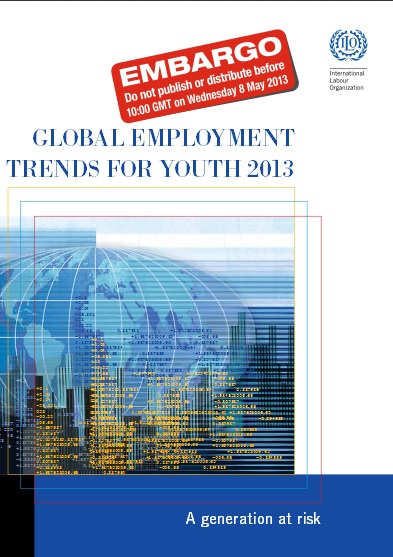
On 20 May the International Labor Organization (ILO) released their Global Employment Trends for Youth 2013 report which outlines the employment environment for people aged 15 to 29 in nations around the world.
Among the statistic were NEET rates among 34 OECD countries’ young people. A NEET (Not in Education, Employment, or Training) rate is the percentage of youth who are not working or in school of any kind.
On average, 15.8 percent of tens and young adults fall in this category in developed countries. The following is a full list of the studied countries.
1 – Luxembourg (7.1%)
2 – Netherlands (7.2%)
3 – Norway (8.5%)
4 – Slovenia (8.8%)
5 – Switzerland (9.7%)
6 – Japan (9.9%)
7 – Iceland (10.3%)
8 – Sweden (10.3%)
9 – Denmark (10.5%)
10 – Austria (11.1%)
11 – Australia (11.8%)
12 – Germany (12%)
13 – Finland (12.6%)
14 – Czech Rep. (13.2%)
15 – Canada (13.5%)
16 – Portugal (13.5%)
17 – Belgium (14.2%)
18 – Poland (15.2%)
OECD average = 15.8
19 – United Kingdom (15.9%)
20 – United States (16.1%)
21 – New Zealand (16.3%)
22 – France (16.7%)
23 – Greece (18.3%)
24 – Slovakia (18.8%)
25 – Hungary (18.9%)
26 – Estonia (19.1%)
27 – Republic of Korea (19.2%)
28 – Brazil (19.6%)
29 – Ireland (21%)
30 – Italy (23%)
31 – Spain (23.7%)
32 – Mexico (24.4%)
33 – Israel (27.4%)
34 – Turkey (36.6%)
[2010 figures]
Upon release of the report South Korean several media outlets wrote headlines such as “One in Five is NEET” or “Our NEET is twice as high as Japan.”
However, these are figures that we should all be equally concerned about. The ILO also mentions that although NEET rates had been dropping steadily since 2009, they are recently on the increase again.
They are also projecting this increase to continue into 2018 causing university graduates more stress and delays in finding a job in an already disheartening market.
Source: Global Employment Trends for Youth 2013 (English), via NicoNico News (Japanese)

 UNICEF: Japan safest country to have a baby
UNICEF: Japan safest country to have a baby Only 11% of Japanese people “willing to fight for their country”
Only 11% of Japanese people “willing to fight for their country” NEET “recruitment” video pokes fun at Japan’s laziest
NEET “recruitment” video pokes fun at Japan’s laziest After eight years as a NEET, our reporter shares the one thing that helped him escape that life
After eight years as a NEET, our reporter shares the one thing that helped him escape that life Recent study once again ranks Japan as the country that sleeps the least
Recent study once again ranks Japan as the country that sleeps the least Our reporter takes her 71-year-old mother to a visual kei concert for the first time
Our reporter takes her 71-year-old mother to a visual kei concert for the first time Disney princesses get official manga makeovers for Manga Princess Cafe opening in Tokyo
Disney princesses get official manga makeovers for Manga Princess Cafe opening in Tokyo Beautiful new Final Fantasy T-shirt collection on the way from Uniqlo【Photos】
Beautiful new Final Fantasy T-shirt collection on the way from Uniqlo【Photos】 Randomly running into a great sushi lunch like this is one of the best things about eating in Tokyo
Randomly running into a great sushi lunch like this is one of the best things about eating in Tokyo Is the new Shinkansen Train Desk ticket worth it?
Is the new Shinkansen Train Desk ticket worth it? All-you-can-ride Shinkansen deal coming to Japan for a limited time
All-you-can-ride Shinkansen deal coming to Japan for a limited time Japanese son tells parents he wants to quit his job, they give the best possible response
Japanese son tells parents he wants to quit his job, they give the best possible response Mr. Sato presents the salad rice cracker showdown (no salads involved)【Taste test】
Mr. Sato presents the salad rice cracker showdown (no salads involved)【Taste test】 Osaka’s creepy cute mascot speaks for first time, adds more fuel the creepy OR cute debate【Video】
Osaka’s creepy cute mascot speaks for first time, adds more fuel the creepy OR cute debate【Video】 The Ultimate Battle for Ham Sandwich Supremacy – we rank Japan’s convenience store sandwiches
The Ultimate Battle for Ham Sandwich Supremacy – we rank Japan’s convenience store sandwiches We try out “Chan Ramen”, an underground type of ramen popular in the ramen community
We try out “Chan Ramen”, an underground type of ramen popular in the ramen community New Studio Ghibli bedding sets are cool in all senses of the word
New Studio Ghibli bedding sets are cool in all senses of the word Our Japanese reporter visits Costco in the U.S., finds super American and very Japanese things
Our Japanese reporter visits Costco in the U.S., finds super American and very Japanese things Foreign English teachers in Japan pick their favorite Japanese-language phrases【Survey】
Foreign English teachers in Japan pick their favorite Japanese-language phrases【Survey】 New Pokémon cakes let you eat your way through Pikachu and all the Eevee evolutions
New Pokémon cakes let you eat your way through Pikachu and all the Eevee evolutions There’s a park inside Japan where you can also see Japan inside the park
There’s a park inside Japan where you can also see Japan inside the park Japanese convenience store packs a whole bento into an onigiri rice ball
Japanese convenience store packs a whole bento into an onigiri rice ball Hanton rice — a delicious regional food even most Japanese people don’t know about, but more should
Hanton rice — a delicious regional food even most Japanese people don’t know about, but more should Final Fantasy, Kingdom Hearts, and Dragon Quest pet product line announced by Square Enix
Final Fantasy, Kingdom Hearts, and Dragon Quest pet product line announced by Square Enix Studio Ghibli releases Kiki’s Delivery Service chocolate cake pouches in Japan
Studio Ghibli releases Kiki’s Delivery Service chocolate cake pouches in Japan Japan’s bone-breaking and record-breaking roller coaster is permanently shutting down
Japan’s bone-breaking and record-breaking roller coaster is permanently shutting down New definition of “Japanese whiskey” goes into effect to prevent fakes from fooling overseas buyers
New definition of “Japanese whiskey” goes into effect to prevent fakes from fooling overseas buyers Foreign passenger shoves conductor on one of the last full runs for Japan’s Thunderbird train
Foreign passenger shoves conductor on one of the last full runs for Japan’s Thunderbird train Kyoto bans tourists from geisha alleys in Gion, with fines for those who don’t follow rules
Kyoto bans tourists from geisha alleys in Gion, with fines for those who don’t follow rules Studio Ghibli unveils Mother’s Day gift set that captures the love in My Neighbour Totoro
Studio Ghibli unveils Mother’s Day gift set that captures the love in My Neighbour Totoro Domino’s Japan now sells…pizza ears?
Domino’s Japan now sells…pizza ears? Toyota built a life-sized Miraidon Pokémon and are letting people test drive it this weekend
Toyota built a life-sized Miraidon Pokémon and are letting people test drive it this weekend New Japanese KitKat flavour stars Sanrio characters, including Hello Kitty
New Japanese KitKat flavour stars Sanrio characters, including Hello Kitty Sales of Japan’s most convenient train ticket/shopping payment cards suspended indefinitely
Sales of Japan’s most convenient train ticket/shopping payment cards suspended indefinitely Sold-out Studio Ghibli desktop humidifiers are back so Totoro can help you through the dry season
Sold-out Studio Ghibli desktop humidifiers are back so Totoro can help you through the dry season Japanese government to make first change to romanization spelling rules since the 1950s
Japanese government to make first change to romanization spelling rules since the 1950s Ghibli founders Toshio Suzuki and Hayao Miyazaki contribute to Japanese whisky Totoro label design
Ghibli founders Toshio Suzuki and Hayao Miyazaki contribute to Japanese whisky Totoro label design Doraemon found buried at sea as scene from 1993 anime becomes real life【Photos】
Doraemon found buried at sea as scene from 1993 anime becomes real life【Photos】 Tokyo’s most famous Starbucks is closed
Tokyo’s most famous Starbucks is closed One Piece characters’ nationalities revealed, but fans have mixed opinions
One Piece characters’ nationalities revealed, but fans have mixed opinions We asked a Uniqlo employee what four things we should buy and their suggestions didn’t disappoint
We asked a Uniqlo employee what four things we should buy and their suggestions didn’t disappoint Princesses, fruits, and blacksmiths: Study reveals the 30 most unusual family names in Japan
Princesses, fruits, and blacksmiths: Study reveals the 30 most unusual family names in Japan Studio Ghibli’s new desktop Howl’s Moving Castle will take your stationery on an adventure
Studio Ghibli’s new desktop Howl’s Moving Castle will take your stationery on an adventure Japanese city makes list of world’s top 10 most livable cities, but not one most people expected
Japanese city makes list of world’s top 10 most livable cities, but not one most people expected Japanese Twitter freaks out over cartoonist’s cute cat freaking out over its tail 【Video】
Japanese Twitter freaks out over cartoonist’s cute cat freaking out over its tail 【Video】 Capybaras around Japan compete to find out which one can bathe the longest
Capybaras around Japan compete to find out which one can bathe the longest “Ugly” South Korean woman goes from “Old Lady Face” to “Dream Girl” with help of cosmetic surgery
“Ugly” South Korean woman goes from “Old Lady Face” to “Dream Girl” with help of cosmetic surgery Pyeongchang Olympics group wipes Japan off the map
Pyeongchang Olympics group wipes Japan off the map Hackers to Gundam: 5 rumors about failed North Korean missile launch surface on Japanese Internet
Hackers to Gundam: 5 rumors about failed North Korean missile launch surface on Japanese Internet Japan second-most popular country to move to according to Google Search analysis
Japan second-most popular country to move to according to Google Search analysis Thai anti-drinking PSA is surprisingly compelling 【Video】
Thai anti-drinking PSA is surprisingly compelling 【Video】 A six-year-old smashed the previous limbo skating record, in case you wanted to know
A six-year-old smashed the previous limbo skating record, in case you wanted to know BTS becomes first-ever K-pop group to present at Grammy Awards
BTS becomes first-ever K-pop group to present at Grammy Awards Study suggests Japanese workers are deeply distrustful of their employers
Study suggests Japanese workers are deeply distrustful of their employers Rubbernecking gone too far? Net users react to crowds taking pics of train hit by suicide jumper
Rubbernecking gone too far? Net users react to crowds taking pics of train hit by suicide jumper Korean Officials to foreign tourists: “If you contract MERS, we’ll give you $3,000!”
Korean Officials to foreign tourists: “If you contract MERS, we’ll give you $3,000!” Can these swimsuit clad cosplay waitresses interest you in some “Shaved Leg Hair Pasta”?
Can these swimsuit clad cosplay waitresses interest you in some “Shaved Leg Hair Pasta”? Free Calpis fresh out of the tap available across Japan in celebration of 100th anniversary
Free Calpis fresh out of the tap available across Japan in celebration of 100th anniversary
Leave a Reply